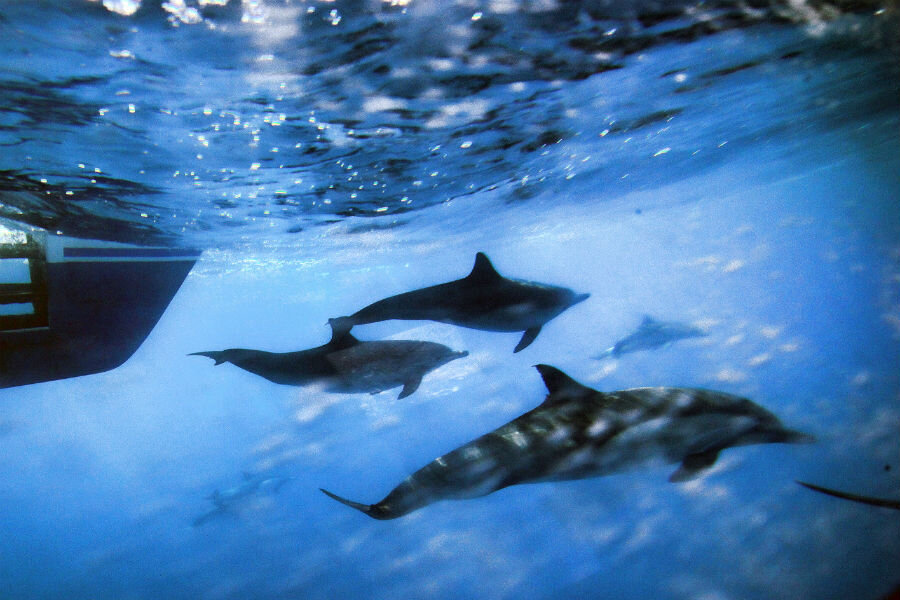Federal judge to Navy: Save the whales (at least in the Pacific)
Loading...
The US Navy is under orders to save the whales – at least the ones near Hawaii and California, where explosives testing and military sonar have proven harmful to whales and dolphins.
A settlement signed by Judge Susan Oki Mollway in Honolulu on Monday brought to an end a nearly three-year-long legal battle between the Navy and conservation groups, led by the Natural Resources Defense Council.
The key provision limits or bans sonar use and explosives in specified areas around the Hawaiian Islands and Southern California, said Earthjustice attorney David Henkin, who represented the plaintiffs, to the Associated Press. "By establishing some safe havens," he said, "the hope is to bring down those estimated numbers of injury and death."
Sonar can disrupt feeding and communication of marine mammals, and it can cause deafness or even death at close range, Mr. Henkin said. Four dolphins died in 2011 when they got too close to an explosives training exercise off the coast of San Diego.
The agreement follows a March ruling that found the Department of Commerce's National Marine Fisheries Services at fault for improperly permitting the Navy to conduct training and testing exercises "even if they end up harming a stunning number of marine mammals, some of which are endangered or threatened," the decision stated.
District Court Judge Mollway, who also ruled on that case, said in her opinion that looking through "reams of pages for some explanation as to why the Navy’s activities were authorized by the National Marine Fisheries Service (NMFS), this court feels like the sailor in Samuel Taylor Coleridge’s 'The Rime of the Ancient Mariner' who, trapped for days on a ship becalmed in the middle of the ocean, laments, 'Water, water, every where, Nor any drop to drink.' "
For decades, conservationists have fought against the use of sonar in areas frequented by large marine mammals. They cite threats to migration and communication patterns, feeding locations, and breeding.
The Navy estimates sailors could inadvertently kill 155 whales and dolphins and injure another 2,000 off Hawaii and Southern California, mostly with explosives. On the Atlantic coast, planned naval activities could cause more than 11,000 serious injuries to the marine mammals.
Lt. Cmdr. Matt Knight, a US Pacific Fleet spokesman, said the settlement preserves key testing and training.
"Recognizing our environmental responsibilities, the Navy has been, and will continue to be, good environmental stewards as we prepare for and conduct missions in support of our national security," Knight said.
Under the agreement, the Navy cannot use sonar in the Southern California habitat for beaked whales between Santa Catalina Island and San Nicolas Island. Sonar also is banned in blue whale feeding areas near San Diego, according to environmental groups involved in the case.
In Hawaiian waters, the agreement forbids sonar and explosives training on the eastern side of the Big Island and north of Molokai and Maui, and caps the number of major training exercises in the channel between Maui and the Big Island. The agreement will protect Hawaiian monk seals and small populations of toothed whales, including the endangered false killer whale.
The deal also places the National Marine Fisheries Service on call to swiftly review any charges of misuse of Navy sonar, Henkin said.
"This settlement proves what we've been saying all along," said Marsha Green, president of the Ocean Mammal Institute, in a statement. "The Navy can meet its training and testing needs and, at the same time, provide significant protections to whales and dolphins by limiting the use of sonar and explosives in vital habitat."
Michael Jansy, director of marine mammal conservation for the group that led the settlement, pointed out the limitations of the ruling.
"The case at issue only pertains to naval activity in waters off Southern California and Hawaii; elsewhere, whales and other marine mammals still remain highly vulnerable to the effects of high-intensity sonar and underwater detonations," Mr. Jansy wrote. "The agreement covers US Navy activities only through the close of 2018 ... yet, as a model, the remedies detailed in the language of the settlement point the way forward."








